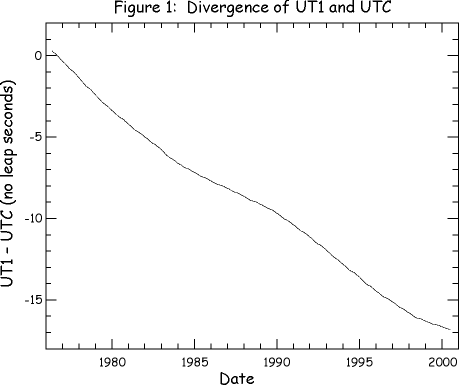Date: Mon, 1 Jan 2007 07:21:10 -0700
Rather than reply in detail to the points raised in the latest
messages - believe me, you've heard before what I was going to say
again - I'd simply like to wish everybody a happy new year. I am
grateful to everybody who has ever contributed to this list and
consider it a mark of the importance of civil timekeeping that the
conversation continues.
Since there are new voices on the list, I might simply direct
interested readers to my own thoughts, unchanged at their core in
more than five years:
http://iraf.noao.edu/~seaman/leap
In short, the current standard has a lot of life left in it.
That said, I have no problem whatsoever with schemes that lengthen
the six month reporting requirements to several years. Steve's five
year plan, recently quoted again, or the decadal scheduling that has
become something of a standard talking point on the list, are each
already entirely legal under the standard if the 0.9s limit on DUT1
could be extrapolated that far in advance.
Perhaps someone "on the inside" could comment on the current state of
the art of multiyear predictions? The most notable feature of leap
second scheduling has been the seven year gap from New Year's Eve
1998 to New Year's Eve 2005. Otherwise figure 1 from my link above
(and attached below) shows a phenomenological slope close to 7 leap
seconds per decade. The question is not whether significant
excursions are seen from this general trend - the question is how
well can they be predicted. Looking at my figure 2 (you'll have to
click through for this one), one will see that a vast improvement in
the state of the art of making short term predictions has occurred
since Spiro Agnew had his the residence at the USNO.
Nobody should be surprised to learn that I will continue resolutely
to oppose the embarrassing and absurd notion of embargoing every 3600
leap seconds into a so-called leap hour. Why 3600? Since this
represents an intercalary period - that appears, only to promptly
disappear from the clocks of the world - why not any other random
number of seconds? How about 1000? Or 1066, to commemorate the
theft of UTC from its Greenwich origins just like the Normans stole
England from the Saxons who stole it from the Celts? Some may join
me in thinking 666 might be the appropriate embargo.
Bottom line - nothing about the current standard forbids scheduling
(and reporting, of course) multiple leap seconds several years in
advance. Obviously it would take at least N years to introduce a new
reporting requirement of N years in advance (well, N years minus six
months). I suspect it would be exceptionally interesting to
everyone, no matter what their opinion on our tediously familiar
issues, to know how well these next seven or so leap seconds could be
so predicted, scheduled and reported. If the 0.9s limit were to be
relaxed - how much must that be in practice? Are we arguing over a
few tenths of a second coarsening of the current standard? That's a
heck of a lot different than 36,000 tenths.
Rob Seaman
NOAO
------

(image/gif attachment: noleap.gif)